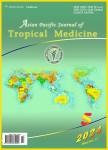Laboratory diagnosis of schistosomiasis mansoni: Current status and future trends
Laboratory diagnosis of schistosomiasis mansoni: Current status and future trends作者机构:Department of Medical Parasitology Faculty of Medicine Mansoura University
出 版 物:《Asian Pacific Journal of Tropical Medicine》 (亚太热带医药杂志(英文版))
年 卷 期:2019年第12卷第6期
页 面:243-249页
核心收录:
学科分类:1002[医学-临床医学] 100201[医学-内科学(含:心血管病、血液病、呼吸系病、消化系病、内分泌与代谢病、肾病、风湿病、传染病)] 10[医学]
基 金:We would like to express our sincere gratitude to Prof. Barbara L.Doughty Texas A & M University U.S.A. for editing and critically revising the scientific contents of the review
主 题:Schistosoma mansoni ELISA miRNA Tegument Polymerase chain reaction
摘 要:Schistosomiasis is a neglected tropical disease that affects about 290 million patients worldwide. Children aged between 5 and 14 years represent 45.8% of the affected patients, in addition, schistosomiasis has been reported in Schistosoma-free areas, mostly because of tourism and immigration from endemic countries. Intestinal schistosomiasis caused by Schistosoma mansoni is mainly diagnosed via direct stool examination for egg detection. Immunological methods are favoured for disease monitoring and preliminary checking for communities in areas with low infection rates, and for patients with light and chronic infections where parasitological tests are negative. PCR-based diagnostic techniques are more sensitive, but expensive. Tegument proteins and miRNAs are promising markers for diagnosis of schistosomiasis. Here we review the diagnostic methods for schistosomiasis mansoni aiming to reach a standardized technique for diagnosis of early infection to help better control of the disease.



